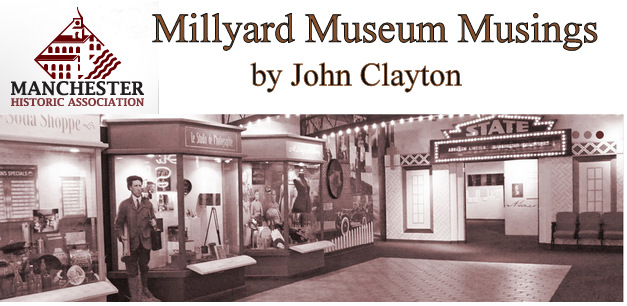
Okay, so I was a little naive, but there was a time in my life when I truly believed that the most fun you could possibly have in your pajamas was at a drive-in movie.
Now I know better.
Over the years, through countless hours of personal research, I’ve discovered that it’s possible to have a lot more fun in my PJs – tons more, in fact – but that’s another story for another day. And another place. Like the ”Penthouse Forum”
Meanwhile, hop in the trunk. We’re off to the drive-in.
I miss the warm summer nights when my father would somehow manage to navigate his hulking black Chrysler between two speaker poles – a feat that occasionally required the use of semaphore flags – after which we Clayton boys would sprint wildly toward the playground beneath the screen.
And yes, we wore pajamas. I still have the emotional scars. See, mine were hand-me-downs for one thing, hand-me-downs that immortalized Hopalong Cassidy (Official Nickname: ”The Cowboy Dork”). All the other kids wore the stylish Davy Crockett line of sleep wear, complete with moccasins and coonskin caps.
Thanks to years of therapy, I’m willing to re-visit the scene of this psychic trauma – the drive-in, I mean – but let’s go back to the beginning.
It was June 30, 1940, when the first drive-in theater opened in the Queen City, only it wasn’t called a drive-in. Barney J. Williams, who wanted to link the place to his other amusement enterprise, tinkered with the name a bit and called his new cinema the ”Pine Island Park-In Theatre.”
The first feature film Barney booked was ”Hell’s Angels” (starring Jean Harlow and James Hall). It was a thrilling spectacle of aerial warfare that he hoped would start things off with a bang.
It did.
Moments after the film began, all of the residents of the Goffe’s Falls area – well, those who hadn’t scurried to their bomb shelters – were banging on the door of the projection booth.
See, the window-mounted car speaker hadn’t been invented yet, so early drive-in theaters like Pine Island just used huge speakers mounted atop the screen. That sound system – ”the best obtainable, insuring perfect reception in every point on the lot” – convinced South End residents that they were under aerial attack.
Forget about Dec. 7, 1941.
In Goffe’s Falls, June 30, 1940, is a date which will live in infamy, and, after being bombarded with complaints, Barney reluctantly closed his outdoor ” autotorium.”
Shortly thereafter, RCA developed a small, individual speaker that patrons could attach to their car window. While this advance helped eliminate loud speakers and noise complaints, it also eliminated car windows if you forgot to take them off before leaving.
By July 10, 1948, Barney was back in business. Let the record show that his resurrection selection was ”Sundown” (Bruce Cabot, Gene Tierney), which was either very coy or amazingly coincidental, given the starting time.

Within a year, Pine Island had competition. In the “Grenier Heights” section of South Willow Street, Jacob Asadourian opened the Manchester Drive-In with ”Kiss of Death” starring Victor Mature. Three weeks later, J. Armand Bourque started luring patrons to the Sky-Ray Outdoor Theater in Hooksett to see ”Forty Thousand Horsemen” with Grant Taylor.
In true capitalist fashion, the battle for customers raged. Prices were fairly uniform – 50 cents for adults, free for the kiddies – so special promotions (if I may borrow the title of a certain movie studio) became paramount. On any given night, Pine Island might offer six free rides at the amusement park, the Manchester Drive-In could have free fire engine rides and the Sky-Ray may have tempted viewers with exotica like archery exhibitions.
”And we had a train that my father got in California,” said Andy Bourque. ”It circled the whole parking area. Kids loved the place.”
No one loved it more than Andy, who never needed HBO. His father had a picture window built into their home on the drive-in lot, then he installed a permanent speaker in the living room so they could watch movies every night.
The entertainment stakes got even higher on Aug. 15, 1956. That’s when Ray Starita got into the act with the Bedford Grove Drive-In. His first flick was ”Bhowani Junction” with Ava Gardner and Stewart Granger, another appropriate film choice seeing as how Ray had a zoo at his disposal.
”It’s true. Before they built the drive-in, there used to be a zoo on the lot, so we offered free elephant and pony rides,” said Bob Robie, who managed the Grove for years. ”You couldn’t start the movie until about 8:30, but if we had a Disney movie, we’d be sold out by 7 o’clock. The line would be all the way down Second Street and all the way up to the Wayfarer.”
With everyone in town going out of their way to cater to the family trade, one enterprising woman in Litchfield took the opposite tack.
Theresa Duffault wasn’t after the family trade. Okay, maybe Hugh Hefner’s family, but her ”adult film” enterprise was such a roaring success – I swear it was located on Talent Road – that she had to install a special lane so cars could get out after being turned away.
 Yes, passion raged on the silver screen at the Litchfield Drive-In. And off the screen. Just like any other drive-in, for that matter. There was passion aplenty in the Pontiacs and Plymouths that filled most drive-in theaters. Just ask Bob Robie.
Yes, passion raged on the silver screen at the Litchfield Drive-In. And off the screen. Just like any other drive-in, for that matter. There was passion aplenty in the Pontiacs and Plymouths that filled most drive-in theaters. Just ask Bob Robie.
”We used to take up a lot of collections for the Jimmy Fund, and that could be a problem, especially in the back rows,” he laughed. ”Some guys would just throw five bucks out the window to make us go away.”
Not all drive-in patrons parted with their cash so willingly. When admission climbed to two bucks a head, it was commonplace to send a solo driver into the lot while others came in through the woods. And then there was the trunk.
”We had one fella who put his wife in the trunk of this big old Buick, but once he got onto the lot, he couldn’t get the trunk open,” Bob said. ”After a while, she thought she was going to suffocate, so she started hollering and screaming. We had to get him a crowbar to pry the trunk open. I don’t know how much it cost him to fix the thing, but I do know we charged him the extra two bucks when we got her out.”
Even with the deadbeats, the drive-ins were big business, but not big enough to prevent a conspiracy of the economic fates that ultimately wiped them out. First, rising real estate values made them targets for mall-minded developers (check out the fate of the Manchester, Sky-Ray and Bedford Grove sites) and later on, any privacy afforded by a car was rendered obsolete by the VCR.
Still, I wish the local drive-ins would come back.
I’d even wear PJs again.
Do Davy Crocketts come in a 40 regular?

John Clayton is Executive Director of the Manchester Historic Association. You can reach him with your historical (or existential) questions at jclayton@manchesterhistoric.org.
 You’re one click away! Sign up for our free eNewsletter and never miss another thing
You’re one click away! Sign up for our free eNewsletter and never miss another thing







